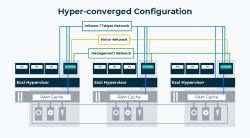Deployment Options for Virtual SAN Configurations
|
Option 1: Hyperconverged Virtual SAN is installed directly on a Windows Server-based host which is running an application or Hyper-V |
The host (also known as the Virtual SAN node) is added to the server group as a DataCore Server. The Virtual SAN node creates one or more disk pools and adds local disks. The Virtual SAN node can create highly-available mirrored virtual disks using the local pool as the primary storage source and a pool from another DataCore Server as the secondary storage source. Mirrored virtual disks are then directly served to the Virtual SAN node to use as storage resources for applications running on that host. |
|
Option 2: Hyperconverged Virtual SAN is installed on one or more Windows Server-based virtual machines that are running on Hyper-V, an ESX host or other non-Windows-based hypervisors |
In this case, the virtual machine also known as the Virtual SAN node) is added to the server group as a DataCore Server. The ESX host or Hyper-V host must be registered as a host in the server group. The Virtual SAN node creates one or more disk pools and adds local disks made available through physical hard disks (Hyper-V) or Raw Device Mappings (ESX or non-Windows-based hypervisors) from the local host. The Virtual SAN node can create mirrored virtual disks using the local pool as the primary storage source and a pool from another DataCore Server as the secondary storage source. Mirrored virtual disks are then directly served to the hypervisor host or to another DataCore Server in the server group. In order to serve virtual disks directly to the hypervisor host, a hypervisor host must be declared for each Virtual SAN node. |
Generally, each Virtual SAN node contributes its locally-attached storage to pools in the server group. All uninitialized block storage devices attached to the Virtual SAN node can be used as storage resources for pools. Multiple disk pools can be created on a single Virtual SAN node. Their storage resources can be combined with other Virtual SAN nodes, integrated into a central SANsymphony SAN, or Cloud storage. Internal storage resources may be shared in a highly-available configuration with multiple Virtual SAN nodes or across a cluster of servers. A DataCore Hyperconverged Virtual SAN can consist of from one to 64 Virtual SAN nodes. The Virtual SAN node does not need to be configured to contribute storage, but instead can be configured to host applications that access storage directly from the pools.
This graphic shows a deployment of SANsymphony software into multiple virtual machines on each ESXi host of a VMware cluster.
Each Virtual SAN node must be properly licensed to run Hyperconverged Virtual SAN. Hyperconverged Virtual SAN is licensed per node according to the Capacity license activated on the node.
